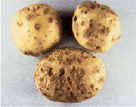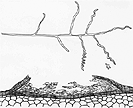Reports on Plant Diseases |
| RPD No. 909
- Common Scab of Potato
|
October 1988
|
[ Symptoms
] [ Disease Cycle ] [ Control
]
Common scab of potatoes is caused by Streptomyces scabies,
a very prevalent, soil-inhabiting bacterium. This serious disease can
be found in all potato-growing areas throughout the world. The scab organism
sometimes occurs in soils where potatoes have never been
grown. In most potato soils, however, scab was probably introduced with
infected seed tubers. The major loss from common scab is lower market
quality because tubers are unsightly or disfigured and have poor customer
appeal. Where scab is severe, yields also may be reduced. The disease
causes an annual loss of several million dollars in the United States.
Back to Top
SYMPTOMS
The first symptom of common scab is the appearance of
small, brownish specks or spots (lesions) on the young tubers. These spots
(usually circular) soon enlarge, darken, and become corky. Certain lesions
may merge to form large, irregular scabby areas. Some may be raised slightly
above the surface of the tuber; others may be somewhat sunken. The lesions
may be so numerous as to give a russeted appearance to the entire tuber.
Under certain conditions the scab lesions become quite deep, pitted, and
dark brown to almost black (Figure 1). Deep cracking and pitting of the
potato surface is often aggravated by attacks of millipedes or the larvae
of the potato flea beetle and garden symphylans, which apparently break
down the cork (periderm) layers. This allows the pathogen to invade the
tuber to a depth of about 1/4 inch. The causal bacterium also produces
rather inconspicuous, tan to brown lesions on potato roots, underground
stems, and stolons. If scabbed potatoes are stored, they tend to shrink
and are often invaded by secondary, soft-rotting organisms.
|

Figure 1.
Sunken scab lesions (courtesy R. Loria)
|
|
The scab bacterium is disseminated in infected tubers
and fleshy roots or in soil. The bacterium overwinters on living roots
of weeds and crop residue left in the field or garden. Wind, splashing
rain, surface-drainage water, farm machinery, and tools all move soil
from one location to another and thus spread the pathogen. The bacterium
even survives passage through the digestive tract of animals and is distributed
with manure. Once the soil becomes infested, it generally remains so indefinitely.
Scab can attack potato tubers grown in soil within a
wide temperature range of about 50° to 88°F (10° to 31°C)
with an optimum of 68° to 72° (20° to 22°C). The organism
can grow, however, at temperatures as low as 41°F (5°C) and as
high as 106°F (40.5°C) with an optimum of 77° to 87°F
(25° to 30°C). Generally scab is more severe in dry soils, especially
those deficient in organic matter, and becomes less severe in moist soils,
although researchers have pointed out some exceptions. The fact that the
Streptomyces bacterium is extremely variable
may partly account for the difference in effectiveness of control measures
at various locations and in different soil types. Certain strains or races
of the bacterium cause scab on fleshy roots or tubers and damping-off
or seedling blight of many kinds of plants. The list includes beets (garden
and sugar), carrot, dahlia, eggplant, mangel, onion, parsnip, radish (Figure
2), rape, rutabaga, salsify, spinach, Swiss chard, turnip, and several
species of weeds. A closely related species of Streptomyces causes soil
rot or pox of sweet potato.
The Streptomyces bacterium
is a saprophyte that can survive indefinitely either in its vegetative
myceloid form or as minute spores (Figure 3, above) in most soils, except
very acidic ones. The vegetative form consists of slender, branched mycelium
with few or no cross walls. The spores are cylindrical or ellipsoid and
are produced on specialized spiral hyphae that develop cross walls from
the tip toward their base. As the cross walls constrict, spores are pinched
off at the tip and eventually break away from the hypha. The spores germinate
by means of one or two germ tubes, which develop into the vegetative myceloid
form. Young, rapidly growing potato tubers are most susceptible. The pathogen
can penetrate through natural openings (lenticels, stomata), mechanical
or insect wounds, or usually occur under conditions when tubers are enlarging
most rapidly. Following penetration the pathogen grows between or through
a few layers of cells. The cells then die and the bacterium feeds on them
as a saprophyte. The organism also secretes a substance that stimulates
the living cells surrounding the lesion to divide rapidly and to produce
several layers of cork cells (periderm) that isolate the bacterium and
surrounding tuber cells (Figure 3, below). As the tuber cells–which
are cut off by the cork layer–die, the pathogen subsists on them.
The cork cell layers are pushed outward and sloughed off and the pathogen
grows and multiplies in the additional dead cells which results in the
development of large scab lesions.
Resistance is apparently associated with the effectiveness
of the periderm, which underlies the scab lesions and walls them off from
the tuber. In susceptible potato cultivars with deep scab lesions, successive
layers of periderm form as penetration progresses. In resistant cultivars
the lesions are shallow and a single periderm layer seems to prevent further
infection. Different types of lesions may develop on the same tuber, which
may reflect differences in pathogenicity between strains of the organism
or in the maturity of the tuber surface at the time of infection.
|

Figure
2. Scab on radish roots.

Figure
3. Streptomyces scabies, the common scab of potato bacterium,
as it would be seen under a laboratory microscope. (Above) Slender, branching
myceloid form and three minute spores; (Below) section of an old scab
lesion showing a layer of periderm (cork) cells (drawing by L. Gray).
|
Back to Top
|
All of the following measures have been
effective in some cases. Usually a combination of control methods should
be adapted to the cultural practices used in your area.
- The best control is to plant certified, disease-free seed potatoes
of scab-tolerant varieties. Inspect seed tubers carefully before cutting
and planting. Discard all plant materials showing symptoms of scab.
Russet types are generally much less susceptible than are smooth-skinned
varieties. Tolerant varieties may develop significant amounts of scab
when grown in slightly acid to alkaline soils with a history of common
scab. Therefore, the importance of soil pH and past cropping history
to scab development cannot be overemphasized.
- Do not apply barnyard manure, wood ashes, other organic matter,
lime, coarsely ground limestone, nitrate of soda, or other alkaline
materials to fields or gardens just before potatoes are planted. Where
you need to lime potato land for growing legumes or other crops, apply
the lime after harvesting the potato crop.
- Adding sulfur (300 to 3,000 pounds per acre) or an acid-forming
nitrogen fertilizer, such as ammonium sulfate or diammonium phosphate,
to bring the soil down to a pH of 4.8 to 5.2 will generally not be
commercially worthwhile unless acid-tolerant crops can be grown in
rotation with potatoes. Even then, control is often not satisfactory.
The pH level at which potatoes grow satisfactorily, and at which scab
can be reduced appreciably, depends to the great extent on the soil
type and the strains(s) of the scab bacterium that are present. It
is better to educe soil alkalinity gradually than to try to make the
entire change in one year. Annual soil tests should be made to prevent
the soil from becoming too acid.
- Rotation with small grains, grasses, corn, sorghum, soybeans, or
alfalfa may be helpful if a period of 4 or 5 years or more is allowed
between crops of potatoes. Avoid susceptible crops listed previously
in the rotation.
- Turning under a green manure crop just before planting potatoes
has proved beneficial, especially when coupled with liberal amounts
of a high-analysis fertilizer applied at a rate based on a soil test.
- Eradicate weeds, especially fleshy-rooted types, such as pigweed.
- Where possible, irrigate heavily when the tubers are forming (small
swellings on the ends of the stolons). The soil must be kept moist
for 4 to 6 weeks. This may involve irrigating every 4 or 5 days in
hot, dry weather. Avoid over-watering since it may cause rotting of
the tubers and poor vine growth.
- Good control of scab in mineral soils has been
obtained by thoroughly incorporating pentachloronitrobenzene (Terraclor,
PCNB) into the top 4 to 6 inches of soil at or just before planting.
Apply the chemical as a band in the furrow and then disk in. Since
PCNB is available in a number of formulations (dusts, granules, wettable
powders, emulsions), follow the manufacturer’s directions carefully
as printed on the container label. PCNB does not control scab in peat
(muck) soils. Besides controlling scab, PCNB also reduces infections
by Rhizoctonia.
Back to Top |
Information concerning insecticides, weed control, varieties, and other recommendations
can be found in the Illinois Homeowners' Guide to Pest Management, available
at your nearest Extension office.
|



